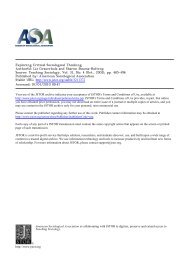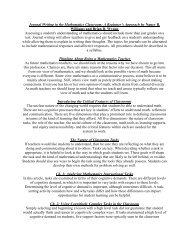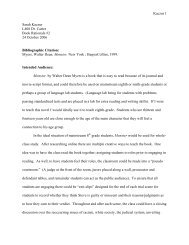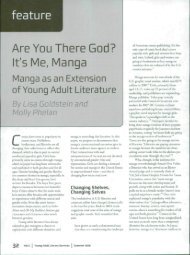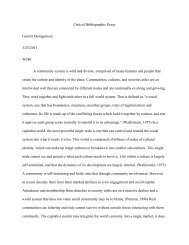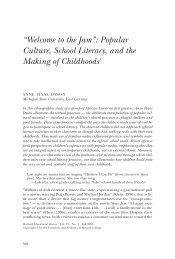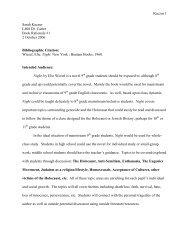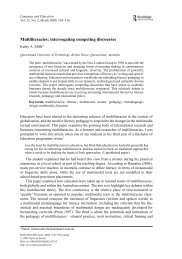FIGURE 1Anatomy of professional development supportHead1. Characteristics ofeffective teachingof African Americanstudents2. Changing concept ofadolescentiiteracyRadnus iiteracy framework(Refiected best practices in <strong>reading</strong>/literacy education)Body1. Read-aiouds2. Guided <strong>reading</strong> (BDA)3. independent <strong>reading</strong>4. Word study/vocabulary5. WritingLegsReadingspecialistK-3Resources1. Human2. MaterialsReadingspecialist4-8Resources1. Human2. Materialscialist with the school context:• Provide professional development supportthat is anatomically complete (see Figure 1).• Discuss factors that include, but arc not limitedto, instructional practices that have the potentialto improve students' <strong>reading</strong> achievement.• Provide teachers with the physical supportsand materials <strong>for</strong> instructing the students.I expanded my role as <strong>reading</strong> specialist beyondthe initial literacy framework to align my ef<strong>for</strong>tswith the needs of the teachers and students atRadnus Elementary. Lyons and Pinnell (2001) suggestedthe need <strong>for</strong> literacy programs with a cohesivesystem (i.e., an arrangement of things sointimately connected that they <strong>for</strong>m a unifiedwhole greater than the sum of their parts). Usingthe idea of a cohesive system, I examined threebodies of literature as being intimately connectedand necessary to frame my role as <strong>reading</strong> specialistat Radnus Elementary. Understanding of the students'culture and literacy in.struction specifically<strong>for</strong> adolescents were placed at the core of the enhancedsupports (see Table 2).There were several reasons <strong>for</strong> this b<strong>road</strong>erframing. First, teachers of African American studentsfrom impoverished urban communities oftenhave students with a wider array of developmentalskills and cultural barriers than do other teacherswho are not similarly situated (Louis & Miles.1990}. This problem is exacerbated when teachersA <strong>road</strong> <strong>map</strong> <strong>for</strong> <strong>reading</strong> spvcialisis <strong>entering</strong> <strong>schools</strong> witlKnit cxvmpUiry I'cailinfi prof^rums
Educating AfricanAmerican studentsLegitimate African Americanstudents' culture and makeit a reference <strong>for</strong> learning.Resist curricuiumorientations that stifle orpostpone academic growth.Engage students in authenticdiscussions where theycan analyze their realitiesin the context of thecurriculum and discussstrategies <strong>for</strong> overcomingacademic and societalbarriers.Guide students towardacademic success andculturai competence.Address students' cognitive,affective, social, emotionai,and developmental needs.Require students to meethigh academic standards.TABLE 2Three bodies of literatureTeacher professionaldevelopmentEstablish a strong conceptualbasis when impiementing theprofessional developmentsupport.Ground professionaldevelopment support inteachers' own work and inresearch that is pertinent tothe support.Make continuous learning avalued part of the professionaldevelopment support.Sustain the culture of theprofessional developmentsupport.Be context sensitive.Systematically monitor theimpact and involve teachersin the evaluation process.Assure available resourcesand adeguate support <strong>for</strong>teachers when their guestionsand concerns emerge.Provide support that translatesinto visible changes instudents' academicper<strong>for</strong>mance.Adolescent literacyRecognize that the conceptof adolescent iiteracy ischanging.Work to bridge the gapbetween adolescents' inschoolliteracies and out-ofschoolliteracies.Recognize that adolescentsare developing a sense ofself and that they draw onmuitiple iiteracies to definethat self.Provide expiicit strategyinstruction.Structure supportiveenvironments.Involve students in theassessment process anddevelop an assessment planthat pays attention to theircognitive and affectiveneeds.responsible <strong>for</strong> these students have a limited conceptof what it means <strong>for</strong> their students to be literate.A limited concept of pedagogical theories can alsointerfere with advancing the literacies of AfrieanAmerican students. A closer look at the "goodteaching" of African American students {Foster,1993; Irvine, 1991; Ladson-Billings, 1995;Lipman. 1995) has led to a distinctive educationalphilosophy and pedagogy considered effective <strong>for</strong>African American students.Second, with regard to professional development<strong>for</strong> teachers, what little is invested is too oftenspent on training aimed at making conventionalteachers a little better at what they conventionallydo by making them more conscious of what theyhave been doing all along. There is a need to helpteaehers think differently about their work andwork differently because of what they think(Schlechty, 1990).Third, the concept of literacy <strong>for</strong> older childrenis changing. An emerging concept of literacy <strong>for</strong>older students moves beyond cognitive approachesconfined to in-school literacy materials <strong>for</strong>teaching students ways to handle text {Moje,Young, Readenee, & Moore, 2000). It encompassescomplex conceptions of literacy, and it is notlimited to in-school literacy that is insufficient <strong>for</strong> agrowing population of linguistically, culturally, andsocioeconomically diverse students (Greenleaf,Schoenbach, Cziko, & Mueller, 2001; Hull &Schultz, 2002).Several steps were taken to support the teachers'use of this b<strong>road</strong>er frame. First, I sought waysto help the teachers reconceptualize their literacyinstruction to address the needs of their studentswho were African American, poor, and living in aneconomically marginalized community. Second, Iinitiated an assessment profile of the students usingThe Readinji Teacher Vol. 58, No. 1 September 2004



